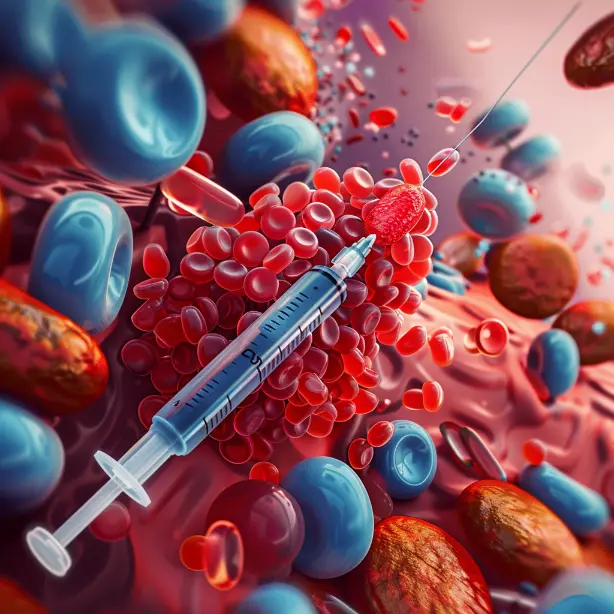Hashimoto’s thyroiditis is a prevalent autoimmune disorder that primarily affects the thyroid gland, leading to hypothyroidism, or an underactive thyroid. While the direct impact on thyroid function is well known, this condition also has broader metabolic implications, including effects on liver health. One of the significant challenges for individuals with Hashimoto’s is the potential for impaired lipid metabolism, which can result in fat accumulation in the liver, a condition known as non-alcoholic fatty liver disease (NAFLD). Understanding this connection and the potential role of specific nutrients in supporting liver health is crucial for managing overall health in Hashimoto’s.
The Link Between Hashimoto’s and Liver Health
The thyroid gland produces hormones—mainly thyroxine (T4) and triiodothyronine (T3)—that are essential for regulating metabolism. In Hashimoto’s thyroiditis, the immune system attacks the thyroid, often leading to decreased production of these hormones. Even when T4 levels are managed with medication, the conversion of T4 to the more active T3 can be impaired. This impairment affects metabolism throughout the body, including in the liver.
T3 is critical for lipid metabolism, helping the body break down fats for energy. When T3 levels are low, the liver’s ability to process fats efficiently diminishes, leading to fat accumulation in the liver. Over time, this can progress to NAFLD and, in more severe cases, non-alcoholic steatohepatitis (NASH) and liver fibrosis.
How Impaired Thyroid Function Leads to Liver Fat Accumulation
- Reduced Metabolic Rate: With lower T3 levels, the body’s basal metabolic rate (BMR) decreases, leading to fewer calories being burned at rest and more being stored as fat.
- Impaired Lipid Metabolism: T3 is essential for lipid metabolism. When its levels are insufficient, the liver’s ability to metabolize lipids is compromised, leading to increased fat storage in the liver .
- Insulin Resistance: Hypothyroidism is often associated with insulin resistance, a condition where the body’s cells do not respond effectively to insulin. This can lead to increased fat accumulation in the liver, as insulin resistance increases the amount of free fatty acids in the bloodstream .
- Fatigue and Reduced Physical Activity: Fatigue, a common symptom of hypothyroidism, often leads to decreased physical activity, which further contributes to weight gain and fat accumulation.
Nutrients That Support Liver Health and Lipid Metabolism
While managing thyroid hormone levels is crucial, certain nutrients can also play a supportive role in promoting liver health and improving lipid metabolism in individuals with Hashimoto’s. Here are four key nutrients that may help:
1. Choline
Choline is a vital nutrient for liver function, particularly in the transport of fats from the liver to other parts of the body. It is crucial for the synthesis of phosphatidylcholine, a component of very low-density lipoproteins (VLDL), which are responsible for exporting fats out of the liver. Adequate choline intake can help prevent fat accumulation in the liver, reducing the risk of NAFLD .
Dietary Sources: Eggs, liver, fish, nuts, and cruciferous vegetables.
2. Inositol
Inositol, particularly myo-inositol, plays a significant role in insulin signal transduction, which is essential for maintaining insulin sensitivity. Improved insulin sensitivity can help reduce fat accumulation in the liver and support overall metabolic health. Additionally, myo-inositol has been shown to improve thyroid function, which may aid in the conversion of T4 to T3 .
Dietary Sources: Whole grains, nuts, seeds, and certain fruits like cantaloupe and oranges.
3. Methionine
Methionine is an essential amino acid involved in methylation processes, which are critical for liver detoxification and the synthesis of important molecules like glutathione. Methionine supports liver health by aiding in detoxification and reducing fat accumulation. Its role in producing glutathione, a potent antioxidant, helps protect liver cells from oxidative damage .
Dietary Sources: Meat, fish, dairy products, and plant-based sources like Brazil nuts and sesame seeds.
4. Taurine
Taurine is an amino acid that promotes the oxidation of fatty acids, helping to reduce fat accumulation in the liver. It is also essential for bile salt formation, necessary for the digestion and absorption of dietary fats. Additionally, taurine’s antioxidant properties help protect the liver from oxidative stress, which is particularly beneficial for individuals with NAFLD .
Dietary Sources: Meat, fish, dairy products, and some energy drinks (though supplements are also available).
A Comprehensive Approach to Liver Health in Hashimoto’s
While these nutrients can provide valuable support for liver health and lipid metabolism, they should be considered part of a comprehensive approach to managing Hashimoto’s thyroiditis. This approach includes:
- Thyroid Hormone Management: Ensuring that thyroid hormone levels are appropriately managed through medication and regular monitoring.
- Balanced Diet: Incorporating a diet rich in these nutrients, along with other liver-friendly foods, can help support overall health.
- Physical Activity: Engaging in regular physical activity can help improve metabolic rate, enhance insulin sensitivity, and reduce fat accumulation.
- Medical Guidance: Consulting with healthcare providers or registered dietitians before starting any new supplements or making significant dietary changes is essential, especially for individuals with existing health conditions or those taking other medications.
Conclusion
Liver health is a crucial aspect of overall well-being, particularly for individuals with Hashimoto’s thyroiditis. By understanding the connection between impaired thyroid function and liver fat accumulation, and by incorporating supportive nutrients like choline, inositol, methionine, and taurine, individuals can take proactive steps to manage their health. As always, a comprehensive approach that includes medical management, dietary considerations, and lifestyle adjustments is key to achieving the best outcomes.
Sources:
- T3 and Lipid Metabolism: Liu YY, Brent GA. Thyroid hormone and the brain: Mechanisms of action in the developing brain and in neurological disorders. Endocrine Reviews. 2021;42(3):246-277. doi:10.1210/endrev/bnaa031.
- Insulin Resistance and Hypothyroidism: Shomon M, et al. Insulin resistance in hypothyroidism. Thyroid. 2020;30(1):1-9. doi:10.1089/thy.2019.0406.
- Choline and Liver Health: Corbin KD, Zeisel SH. Choline metabolism provides novel insights into non-alcoholic fatty liver disease and its progression. Current Opinion in Gastroenterology. 2012;28(2):159-165. doi:10.1097/MOG.0b013e32834e7b4b.
- Inositol and Insulin Sensitivity: Genazzani AD, et al. Effects of myo-inositol on insulin resistance and hormonal parameters in women with polycystic ovary syndrome. Gynecological Endocrinology. 2008;24(8):392-397. doi:10.1080/09513590802217752.
- Inositol and Thyroid Function: Nordio M, Pajalich R. Combined therapy with myo-inositol and selenium ensures euthyroidism in subclinical hypothyroidism patients with autoimmune thyroiditis. Journal of Thyroid Research. 2013;2013:424163. doi:10.1155/2013/424163.
- Methionine and Liver Detoxification: Zeisel SH, Da Costa KA. Choline: An essential nutrient for public health. Nutrition Reviews. 2009;67(11):615-623. doi:10.1111/j.1753-4887.2009.00246.x.
- Taurine and Liver Health: Militante JD, Lombardini JB. Taurine: Evidence of physiological function in the cardiovascular system. American Journal of Physiology – Heart and Circulatory Physiology. 2002;282(3). doi:10.1152/ajpheart.00832.2001.













